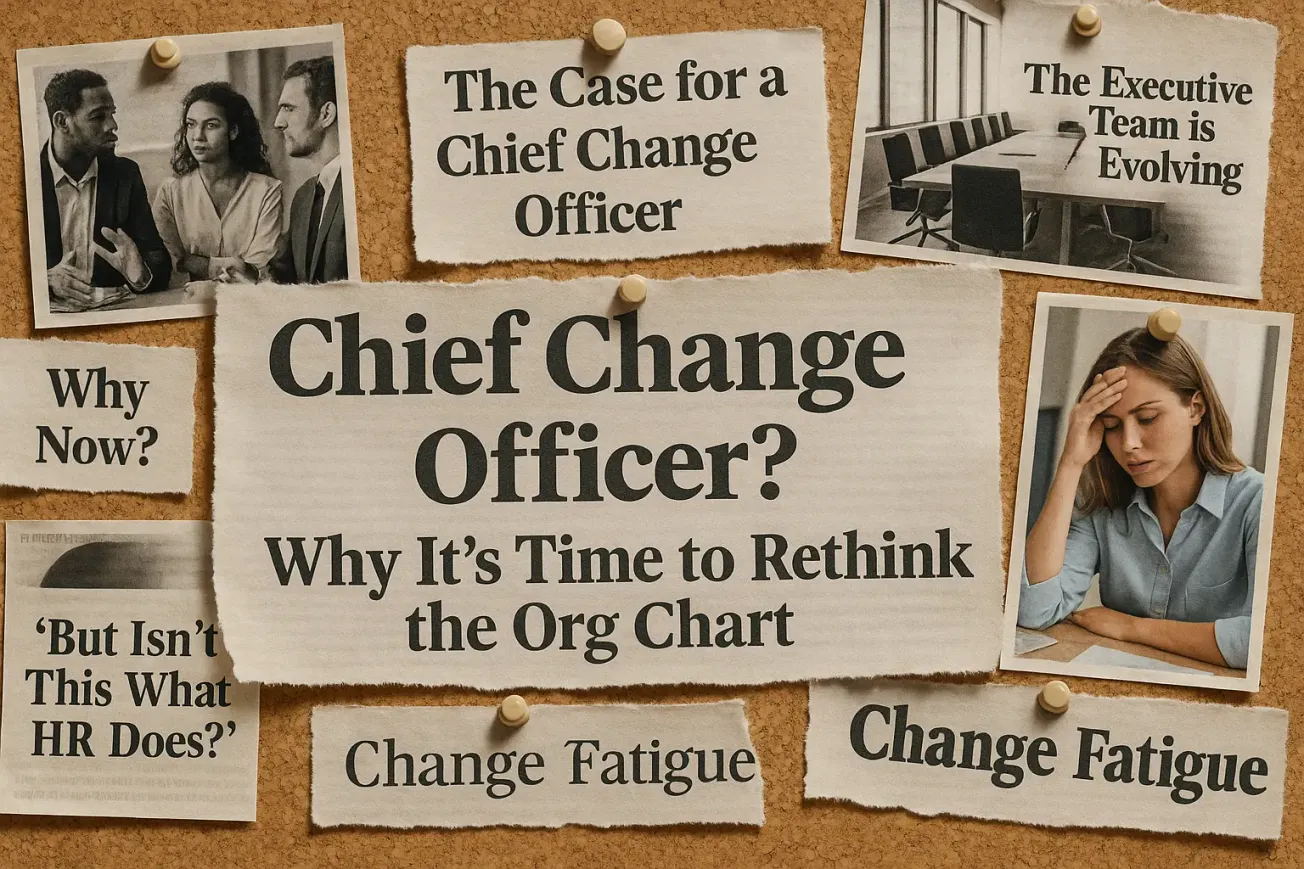The New Change Toolkit
Enterprise Change Management (ECM) has long been a discipline fueled by templates, training decks, and the hard-earned muscle of relationship-building. But as the pace of transformation accelerates, the old toolkit isn't keeping up.
In response, a new wave of digital tools has emerged—each offering a way to scale, streamline, or embed the work of change. While these tools don’t replace change practitioners, they point toward what a modern, digitally augmented practice might look like.
This article explores four such tools—ChangePlan, Pandatron, Matae, and ChangeabilityPro—not as competing solutions, but as signals of what’s possible. We’ll examine what they do, how they fit into the ECM maturity journey, and what practitioners can learn from them, even if you’re sticking with spreadsheets and SharePoint.
The Players: A Landscape of Purpose-Built Tools
ChangePlan
A cloud-based platform designed to support change at scale. It excels at managing change portfolios, stakeholder mapping, and measuring saturation/readiness. Think of it as a PPM tool designed by change professionals for change professionals.
Pandatron
An AI-powered micro-coaching solution that integrates into Slack, Teams, or email to deliver nudge-based behavior change. It surfaces insights from conversations to inform enterprise-level change strategy.
Matae
A workflow-integrated platform that embeds change planning and execution into the Microsoft ecosystem. It offers leader-centric features like role clarity tracking, change nudges, and integration with 365 tools.
ChangeabilityPro
A learning and development platform grounded in behavioral science. Created by veteran change leader Melanie Franklin, it combines videos, templates, and neuroscience-backed microlearning to build change capability.
These tools serve different functions—portfolio visibility, behavioral embedment, leader activation, and practitioner development—yet collectively signal the evolution of ECM into a more dynamic, tech-augmented discipline.
What They Reveal About ECM Maturity
Each of these tools doesn’t just serve a function—it represents a step on the path toward a more mature, integrated, and future-ready ECM capability.
If you’ve worked with Prosci’s ECM Maturity Model or similar frameworks, these tools offer tangible examples of what “Level 3” or “Level 5” might look like in action.
- ChangePlan supports high maturity by giving change leaders and program managers a centralized platform for visibility, alignment, and accountability. It operationalizes enterprise-wide change governance and surfaces saturation risks, stakeholder overload, and change collisions—making it easier to move from reactive to strategic management.
- Pandatron reveals the emerging potential of technology to support behavioral change at scale. It activates reinforcement, coaching, and feedback loops directly in digital workflows. The platform captures emotional and behavioral patterns across the workforce, turning them into insights for change teams.
- Matae addresses the “last mile” of transformation by embedding change into the operational workflow. Many organizations do strategy well but struggle with execution—Matae brings change into the tools employees already use, tracking behavior and accountability within the flow of work.
- ChangeabilityPro tackles capability gaps, giving individuals and teams access to neuroscience-informed content. It supports continuous learning and practice, essential for embedding sustainable change.
Together, these platforms act as maturity accelerators—each aligning with key capability areas: strategic visibility, behavioral reinforcement, leader enablement, and practitioner development.
They also offer a kind of roadmap. If your organization struggles with data, ChangePlan might be your North Star. If you can’t scale coaching, look to Pandatron. If leadership adoption is stalling, Matae offers a model. And if your team is overwhelmed or under-skilled, ChangeabilityPro can help build your foundation.
Benefits for Change Practitioners
Even if you don’t purchase or deploy these tools, they offer significant practical value:
- Inspiration for internal tool-building
Study how ChangePlan tracks readiness, risk, and stakeholder impact. You might replicate that structure in your own Excel, Airtable, or Smartsheet setups. - Model new ways to scale
Pandatron shows how AI and automation can extend coaching reach. Even without their platform, you can mimic the approach with templates, pre-scheduled nudges, or peer-driven reflection sessions. - Help make the business case
Use these tools as visual aids with leadership to show what “good” looks like in a digitally enabled ECM environment. - Fuel continuous improvement and benchmarking
Analyze platforms like ChangeabilityPro to enhance your team’s internal learning paths and microdevelopment efforts. - Build cross-functional credibility
Knowledge of these tools helps position you as a digitally literate partner to IT, HR, and transformation offices. - De-risk experimentation
Prototype elements of these tools internally to test what works before committing to software purchases. Airtable can mimic ChangePlan logic. Microsoft Forms and Power Automate can simulate Pandatron nudges. The possibilities are within reach.
Build-It-Yourself Options: Doing More with Less
Can’t buy a platform? No problem. You can still mirror much of the value using tools you already have:
- ChangePlan → Airtable + Power BI
Track project readiness, stakeholders, and saturation. Visualize trends in Power BI or Google Data Studio. - Pandatron → Forms + Automations
Send recurring reflection prompts using Google or Microsoft Forms. Use Zapier or Power Automate to push nudges into Slack or Teams. Analyze the results in Sheets. - Matae → Teams + Outlook + Planner
Assign role-based tasks via calendar invites. Use Planner or SharePoint for tracking and Power Automate to trigger leadership nudges and alerts. - ChangeabilityPro → Notion + Loom + SharePoint
Build your own learning hub. Record walkthroughs, curate neuroscience tips, and invite your team to log learning paths or reflect on adoption efforts.
These DIY approaches won't match the polish, but they can deliver most of the value—especially when you're piloting or working in resource-constrained environments.
Most importantly, they foster a test-and-learn culture and help you build change tools for your organization, not just in it.
From Inspiration to Action: Getting Started with Digital Tools
This five-minute read barely scratches the surface. It doesn't do justice to the elegance, sophistication, and power built into platforms like ChangePlan, Pandatron, Matae, and ChangeabilityPro. But that’s not the point. The goal here is to act as a catalyst—a spark that encourages you to explore further.
Start by visiting each company’s website and signing up for a demo or a free trial. Many offer downloadable white papers, webinars, or training resources that deepen understanding of their use cases.
Look for practitioner communities hosted by the vendors or in places like LinkedIn, Reddit, or Slack. These communities often share case studies, implementation advice, and real-world lessons you can learn from.
Leverage ChatGPT or other AI tools to brainstorm use cases, design mock dashboards, or simulate nudge sequences. AI can be a fast and forgiving design partner.
And if you're part of a change team or CoE, consider leading a lunch-and-learn or pilot project. These platforms are more than tools—they're a conversation starter about where your ECM practice is headed.
Final Thought: The Future Isn’t Either/Or
The future of ECM won’t be a binary choice between human-led or tech-enabled. It will be a dance between them.
Tools like ChangePlan, Pandatron, Matae, and ChangeabilityPro aren’t silver bullets—but they are signposts. They help us imagine what change work looks like when it’s data-informed, leader-embedded, behavior-aware, and continuously learned.
And as a change practitioner, imagining is step one. Building comes next.
ChangeGuild: Power to the Practitioner™
Frequently Asked Questions
What are “smart tools” in enterprise change management?
Smart tools are digital platforms designed to support change management at scale. They often offer features like stakeholder tracking, behavioral nudges, micro-coaching, learning content, and portfolio visibility—all aimed at embedding change into the flow of work.
Do these tools replace change practitioners?
No. They’re not a replacement but a force multiplier. Tools like ChangePlan or Pandatron help practitioners extend their reach, automate repetitive tasks, and generate insights—freeing up time for strategic work.
Which tools are covered in this article, and what do they do?
- ChangePlan: Centralizes change portfolio management, saturation tracking, and stakeholder insights.
- Pandatron: Delivers AI-powered coaching nudges via Slack or Teams.
- Matae: Embeds change execution and role clarity into Microsoft tools.
- ChangeabilityPro: Builds practitioner and leader capability through neuroscience-based microlearning.
What if I can’t afford new platforms?
You can prototype many of these functions using tools you already have—like Airtable, Microsoft Forms, Slack, or Notion. The article outlines specific DIY pairings that mimic the functionality of commercial platforms.
Why should change leaders explore digital tools now?
Because the pace, scale, and complexity of transformation is accelerating. Tools enable faster feedback, better data, and more sustainable behavior change. Waiting means falling behind in both effectiveness and credibility.
Recommended Reading
If you enjoyed this article, you might also find these helpful:

Scaling change is more than a project—it’s infrastructure.
If you're tasked with building change maturity, standing up a COE, or embedding ECM across portfolios, you're doing the slow, essential work that makes real transformation possible. It’s not glamorous, but it’s strategic.
Let’s make sure you’re not building it alone.
This post is free, and if it supported your work, feel free to support mine. Every bit helps keep the ideas flowing—and the practitioners powered. [Support the Work]









